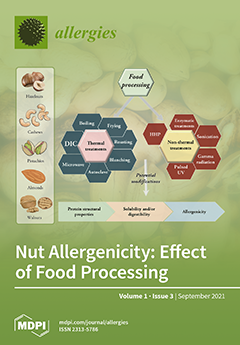Purpose: To elucidate the usefulness of Japanese cedar pollen (JCP)-specific antigen-specific immunoglobulin (IgG) 4 as a biomarker for predicting the efficacy of sublingual immunotherapy for cedar pollen-induced allergic rhinitis. Methods: We divided a total of 105 cases with Japanese cedar pollinosis into three groups: “SLIT Successful,” SLIT Unsatisfactory,” and “SCIT” groups. The SLIT group patients were treated with JCP Droplet (Torii Pharmaceutical Co. Ltd., Tokyo, Japan) for one year from 2015 and were divided into two groups, the SLIT Successful group or the SLIT Unsatisfactory group. The SLIT Successful group (
n = 16) were subjects treated by SLIT only, who were able to experience control of their naso-ocular symptoms without the need for antiallergic rescue agents during the peak season of atmospheric pollen. The SLIT Unsatisfactory group (
n = 76) comprised subjects treated with SLIT only, who did not respond successfully, and were administered with rescue agents to control their naso-ocular symptoms. The SCIT group had been treated with standardized JCP extract (Torii Pharmaceutical Co., Ltd., Tokyo, Japan) for three years from 2012, and were also able to experience control of their symptoms during the peak pollen season without the need for antiallergic rescue agents. We determined the serum level of JCP-specific immunoglobulin E (IgE), IgG, and IgG4 used in the 3gAllergy-specific IgE assay (3gAllergy). The serum levels of periostin and SCCA2 were measured using established ELISA procedures (clones SS18A and SS17B; Shino-Test, Japan) following the manufacturer’s instructions. We then made ROC curves for each group and assessed which index was best able to predict the efficacy of sublingual immunotherapy. Results: Serum JCP-specific IgE was significantly lower in the SCIT group than in the SLIT Successful group and the SLIT Unsatisfactory group (
p < 0.05). Serum JCP-specific IgG was significantly higher in the SCIT group and the SLIT Successful group than in the SLIT Unsatisfactory group (
p < 0.05). Serum JCP-specific IgG4 was also significantly higher in the SCIT group and the SLIT Successful group than in the SLIT Unsatisfactory group (
p < 0.05). There was no significant difference among serum levels of periostin in the SCIT group, the SLIT Successful group, or the SLIT Unsatisfactory group. There was also no significant difference in SCCA2 among the three groups. In terms of ROC curves, a serum JCP-specific IgG4 value greater than 989.5 UA/mL showed the best sensitivity (93.3%) and specificity (94.7%) (
p < 0.05) among other parameters. Conclusions: The serum JCP-specific IgG4 level is significantly correlated with the clinical efficacy of SLIT. Serum JCP-specific IgG4 cutoff levels greater than 989.5 UA/mL were correlated with an effective clinical response to SLIT, with a sensitivity of 93.3% and a specificity of 94.7%.
Full article



